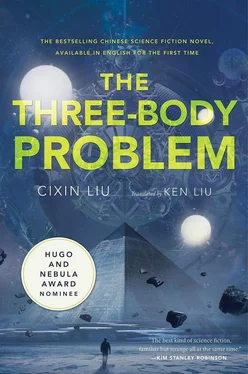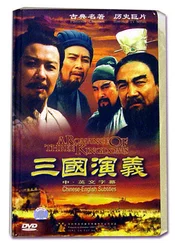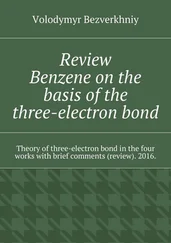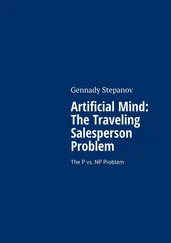I created a second sphere whose mass was equal to the first one’s. Both had perfectly reflective surfaces. They reflected each other’s images, displaying the only existence in the universe other than itself. But the situation didn’t improve much. If the spheres had no initial movement—that is, if I didn’t push them at first—they would be quickly pulled together by their own gravitational attraction. Then the two spheres would stay together and hang there without moving, a symbol for death. If they did have initial movement and didn’t collide, then they would revolve around each other under the influence of gravity. No matter what the initial conditions, the revolutions would eventually stabilize and become unchanging: the dance of death.
I then introduced a third sphere, and to my astonishment, the situation changed completely. Like I said, any geometric figure turns into numbers in the depths of my mind. The sphereless, one-sphere, and two-sphere universes all showed up as a single equation or a few equations, like a few lonesome leaves in late fall. But this third sphere gave “emptiness” life. The three spheres, given initial movements, went through complex, seemingly never-repeating movements. The descriptive equations rained down in a thunderstorm without end.
Just like that, I fell asleep. The three spheres continued to dance in my dream, a patternless, never-repeating dance. Yet, in the depths of my mind, the dance did possess a rhythm; it was just that its period of repetition was infinitely long. This mesmerized me. I wanted to describe the whole period, or at least a part of it.
The next day I kept on thinking about the three spheres dancing in “emptiness.” My attention had never been so completely engaged. It got to the point where one of the monks asked the abbot whether I was having mental health issues. The abbot laughed and said, “Don’t worry. He has found emptiness.” Yes, I had found emptiness. Now I could be at peace in a bustling city. Even in the midst of a noisy crowd, my heart would be completely tranquil. For the first time, I enjoyed math. I felt like a libertine who has always fluttered carelessly from one woman to another suddenly finding himself in love.
The physics principles behind the three-body problem [28] Author’s Note: How three bodies would move under the influence of their mutual gravitational attractions is a traditional problem in classical mechanics that arises naturally in the study of celestial mechanics. Many have worked on it since the sixteenth century. Euler, Lagrange, and more recent researchers (aided by computers) have all found solutions for special cases of the three-body problem. Karl F. Sundman later proved the existence of a general solution to the three-body problem in the form of a convergent infinite series, but the series converges so slowly that it is practically useless.
are very simple. It’s mainly a math problem.
“Didn’t you know about Henri Poincaré?” Wang Miao interrupted Wei to ask. [29] Translator’s Note: Poincaré showed that the three-body problem exhibited sensitive dependence on initial conditions, which we would now understand as characteristic of chaotic behavior.
At the time, I didn’t. Yes, I know that someone studying math should know about a master like Poincaré, but I didn’t worship masters and I didn’t want to become one, so I didn’t know his work. But even if I had, I would have continued to pursue the three-body problem.
Everyone seems to believe that Poincaré proved that the three-body problem couldn’t be solved, but I think they’re mistaken. He only proved sensitive dependence on initial conditions, and that the three-body system couldn’t be solved by integrals. But sensitivity is not the same as being completely indeterminable. It’s just that the solution contains a greater number of different forms. What’s needed is a new algorithm.
Back then, I thought of one thing: Have you heard of the Monte Carlo method? Ah, it’s a computer algorithm often used for calculating the area of irregular shapes. Specifically, the software puts the figure of interest in a figure of known area, such as a circle, and randomly strikes it with many tiny balls, never targeting the same spot twice. After a large number of balls, the proportion of balls that fall within the irregular shape compared to the total number of balls used to hit the circle will yield the area of the shape. Of course, the smaller the balls used, the more accurate the result.
Although the method is simple, it shows how, mathematically, random brute force can overcome precise logic. It’s a numerical approach that uses quantity to derive quality. This is my strategy for solving the three-body problem. I study the system moment by moment. At each moment, the spheres’ motion vectors can combine in infinite ways. I treat each combination like a life form. The key is to set up some rules: which combinations of motion vectors are “healthy” and “beneficial,” and which combinations are “detrimental” and “harmful.” The former receive a survival advantage while the latter are disfavored. The computation proceeds by eliminating the disadvantaged and preserving the advantaged. The final combination that survives is the correct prediction for the system’s next configuration, the next moment in time.
“It’s an evolutionary algorithm,” Wang said.
“It’s a good thing I invited you along.” Shi Qiang nodded at Wang.
Yes. Only much later did I learn that term. The distinguishing feature of this algorithm is that it requires ultralarge amounts of computing power. For the three-body problem, the computers we have now aren’t enough.
Back then, in the temple, I didn’t even have a calculator. I had to go to the accounting office to get a blank ledger and a pencil. I began to build the math model on paper. This required a lot of work, and in no time at all I went through more than a dozen ledgers. The monks in charge of accounts were angry with me, but because the abbot wished it, they found me more paper and pen. I hid the completed calculations under my pillow, and threw the scratch paper into the incense burner in the yard.
One evening, a young woman suddenly dashed into my room. This was the first time a woman had shown up at my place. She clutched a few pieces of paper with burnt edges, the scratch paper I had thrown out.
“They tell me these are yours. Are you studying the three-body problem?” Behind her wide glasses, her eyes seemed to be on fire.
The woman surprised me. The math I used was unconventional, and my derivations took large leaps. But the fact that she could tell the subject of my study from a few pieces of scratch paper showed that she had unusual math talent and that she, like me, was very devoted to the three-body problem.
I didn’t have a good impression of the tourists and pilgrims. The tourists had no idea what they were looking at, only running around to snap pictures. As for the pilgrims, they looked much poorer than the tourists, and all seemed to be in a state of numbness, their intellect inhibited. But this woman was different. She looked like an academic. Later I found out that she had come with a group of Japanese tourists.
Without waiting for my answer, she added, “Your approach is brilliant. We’ve been searching for a method like this that could turn the difficulty of the three-body problem into a matter of massive computation. Of course, it would require a very powerful computer.”
I told her the truth. “Even if we were to use all the computers in the world, it wouldn’t be enough.”
“But you must have an adequate research environment, and there’s nothing like that here. I can give you the use of a supercomputer. I can also give you a minicomputer. Let’s leave together tomorrow morning.”
Читать дальше












